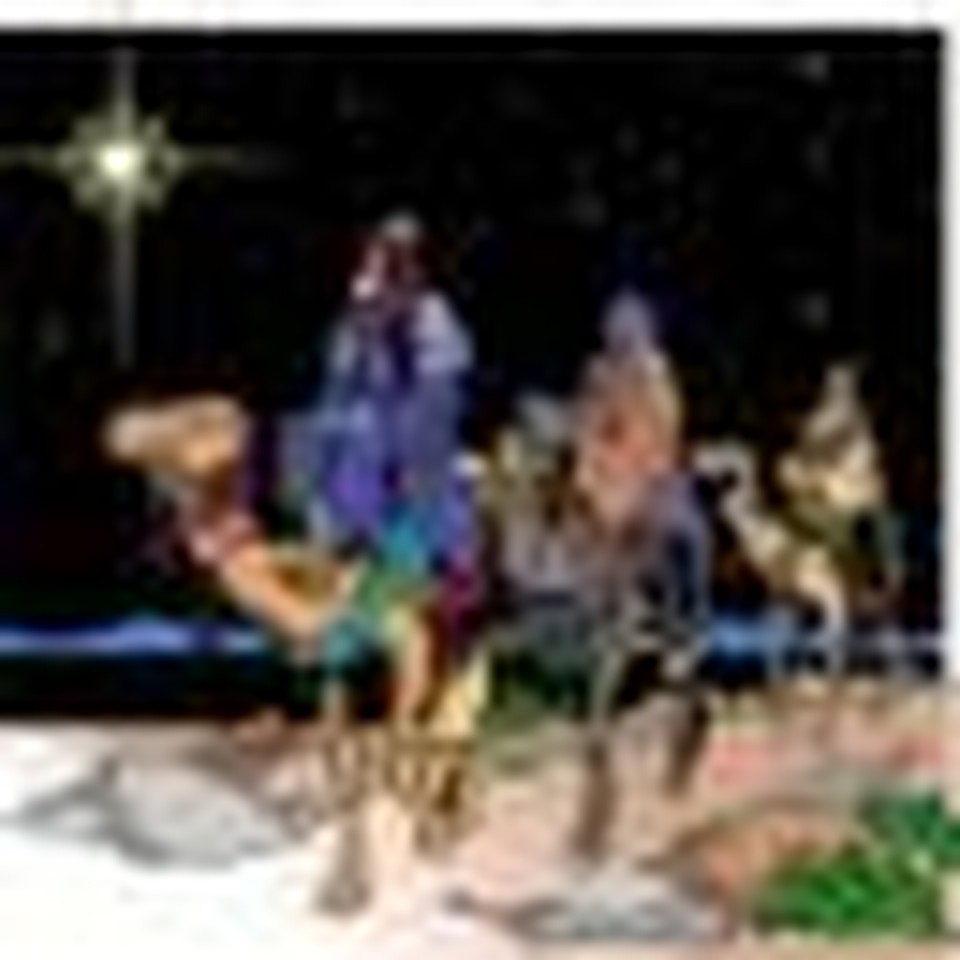How Zoroastrian Magi Made the Original "Star Trek"

On January 6th the Western church celebrates the feast of Epiphany, marking the arrival of the Magi bearing gifts for the Christ child (Matt 2).1 If you've ever sung "The Twelve Days of Christmas," you've chanted off the days between Christmas and Epiphany. But who were these Magi and what inspired them to saddle up their camels and head west?
The word magi is the plural form of the Latin word magus (Greek magos, pl. magoi). In both Latin and Greek, the g is hard like in guru, not soft like giraffe. Originally, the Magoi were a tribe of Medians located in what is now Azarbaijan, a province in northwest Iran encompassing the area between Mt. Ararat and the Caspian Sea. The Magoi served as priests for the other Median tribes. Under the Achaemenids (558-330 BC) they became the priests for the Persian Empire as well, not unlike the way the Levite tribe served the priestly function for the rest of the Israelites. The magi were responsible for ensuring that sacrifices were performed correctly and they interpreted dreams.
While originally polytheists, under Persian influence the magi became Zoroastrians, one of the first monotheistic religions.2
Zoroastrian monotheism is complex. Zoroastrians worship Ahura Mazda as the supreme God, but he created seven other gods (zagatas) who each have their own sphere of influence. Some sources count only six of these divinities, equating the Holy Spirit (Spenta Mainyu) with Ahura Mazda. The Holy Spirit is indivisibly one with Ahura Mazda, yet still distinct, serving as his active agent and even indwelling the righteous.3 In the Hebrew Scriptures Yahweh is manifested by the Word/Angel/Spirit of Yahweh, at times distinct from Yahweh and at times indistinguishable from Him. The Christian doctrine of the Trinity also represents a "complex" monotheism: Christ is the image of the invisible Father, with the Holy Spirit as active agent.
Over time, probably under the influence of the magi, some syncretistic elements crept into Zoroastrianism. In particular, the magi are credited with incorporating the study of astronomy and Babylonian astrology into the religion. It is to this interest in the cosmos that we now turn.
King Antiochus I Theos of Commagene,4 a Hellenized Zoroastrian, erected a statue at Nemrut Dag: a lion with nineteen 8-pointed stars on and around it, identifying the lion as the constellation Leo. The lion has a crescent moon hung around its neck, and above its back are three more stars, these with 16 points and labeled with the Greek names for the planets/gods Jupiter, Mercury and Mars. Modern astronomers calculate that those three planets moved through the constellation Leo on July 6 or 7, 62 BC. Antiochus had been ruling since his father's death in 70 BC, but 62 may have been the year of his coronation or installation by the Roman general Pompey. The title Epiphanes was quite possibly added to his name at the same time: according to inscriptions on the site, his coronation was celebrated as the "Day of Epiphany."
One of the main stars in the constellation Leo is Regulus, thought to be the same as one of the Persian astrologers' four royal stars, Vanant. Long story short: the Nemrut Dag monument indicates what kind of events Zoroastrian astrologers in the first century BC would be looking for and would associate with royal ascents.
The ancients didn't imagine that the planets were compositionally different than stars. What made them different is how they move. Due to the rotation of the earth, the sun, the moon, the stars and the planets all rise in the east and set in the west. The stars stay fixed in their relative positions to each other, and the sun travels through a fixed path across the backdrop of the stars. The planets, however, meander through the night sky—the Greeks called them planetoi, "wanderers." Each planet generally moves eastward through the constellations, but sometimes its movement, from the perspective of the earth (also moving!), causes its path through the distant stars to loop back on itself, heading west. This looping back is called retrograde movement.
This retrograde motion might explain how magi in the east could "follow" a star as it traveled west across the constellations and then stop when the star "hovered" at the end of its westward journey before resuming eastward travel. Still, retrograde motions are common enough that it would take a confluence of astrological events to really get the magi excited. Modern astronomers have noticed two such events:
1. In 6 BC, the earliest date that many scholars ascribe to the birth of Jesus, Jupiter (Greek Zeus) traveled through Aries, the ram, three times (once in retrograde). This triple-cross movement of Jupiter would have been visible right before sunrise or "in the East" (Matt 2:2). A coin minted in Antioch, Syria shows a ram looking over its right shoulder with a bright star on its back, and an image of Zeus on the flip side. This motif has been found on the local coinage dating from 5-55 AD, and the Tetrabiblos of Claudius Ptolemy (2.3) ascribes to Aries astrological influence over the region, including Judea.
2. In 2 BC,5 Jupiter passed through Leo, the lion, and then circled the Zoroastrian royal star, Regulus, while two other planets also passed through or near the same constellation. Some see a natural connection between Leo and the lion of Judah. This confluence is quite reminiscent of the leonine statue at Nemrut Dag.
Either celestial event might have piqued the curiosity of the magi while remaining obscure to Herod or other uninitiated star-gazers.
An open and shut case? Hardly. After all, the Star of Bethlehem could have just been a miracle, like the pillars of fire and smoke that led the Israelites through the desert. But we have an idea of who the magi were: Zoroastrian astrologer-priests. And ancient books, monuments and coins give us an indication of the types of things the magi would be watching for, while a study of astronomy can help us recreate the natural conditions that the magi would have seen 2,000-odd years ago.
Bible Knowledge Quiz:
1. How many Magi were there?
2. What's all this nonsense about astrologers, weren't they kings?
Answers:
1. The text doesn't say. The idea that there are three of them comes from the fact that the magi gave three gifts: gold, frankincense and myrrh. That didn't stop Church historians from naming them Caspar, Balthazar and Melchior. The Syrians gave them more Eastern names: Larvandad, Gushnasaph, and Hormisdas.
2. Psalm 72:10 and 15 make reference to kings bearing gifts, including gold and frankincense, to the king of Jerusalem. The early church fathers are almost universal in describing the magi as learned men from Persia, but the resourceful Tertullian found a way to still use Psalm 72 as a Messianic prophecy by explaining that "the East generally regarded the magi as kings!" (Against Marcion 3.13.)
Notes:
1. The Eastern church celebrates Jesus' baptism, or Theophany, on January 6, and at one point the Nativity was also celebrated on the same day. However, there is currently a thirteen day divergence between the modern Gregorian calendar and the Julian calendar, which many Orthodox churches still use, so Theophany falls on January 19th of the Gregorian calendar, and the Orthodox Christmas falls on January 7.
2. The Zoroastrian prophet, Zarathustra (Greek Zoroaster), broke from his pagan roots and worshipped Ahura Mazda as the only supreme God. Traditional dating places Zarathustra during the 7th-6th centuries BC (contemporary to the Median Empire). However, recent archaeological and linguistic studies of the Gathas—the earliest Zoroastrian writings and the only ones ascribed to Zarathustra himself—have suggested that Zarathustra's reforms might be dated to around 1200 bc. The later, traditional dating may reflect a reworking of the Zoroastrian traditions by our magi to bolster their dominance over religious matters.
3. Modern Zoroastrian theologians sometimes call the zagatas archangels, rather than gods. Similarly, in the Hebrew Bible, elohim can refer to either God or gods (plural), and modern translations often translate elohim with a euphemism like "angels" when it is not referring to God (the Elohim par excellence).
4. Commagene was a small kingdom located north east of Antioch. Commagene had previously been part of the Armenian Empire, which in its glory days stretched from Cappadocia to Persian Media.
5. The traditional dating of Herod's death is 4 BC, based on an eclipse mentioned in Josephus' Antiquities of the Jews 17.167. However, some doubt has been raised about whether all the events Josephus described could have taken place in the short time between that eclipse and Passover. An eclipse in 1 BC is proposed as an alternative.
"Star Trek" is a registered trademark of Paramount Pictures.
Publication date: October 25, 2010
Originally published October 25, 2010.






